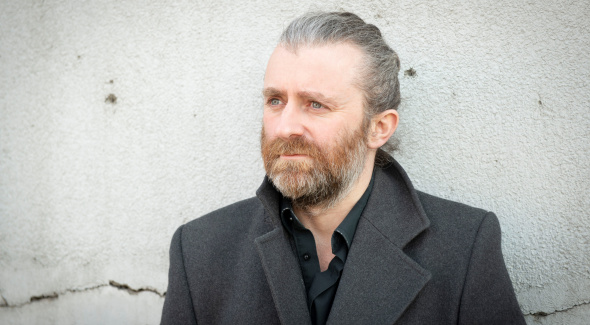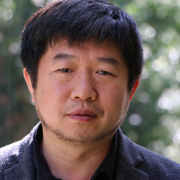Visiting artists professors
- 2022-2023
- 2021-2022
- 2020-2021
- 2019-2020
- 2018-2019
- 2017-2018
- 2016-2017
- 2015-2016
- 2014-2015
- 2013-2014
- 2012-2013
- Historique
2022-2023
2021-2022
2020-2021
Athina Tsangari
Dora Garcia
Ben Russell
Laure Prouvost
Emanuele Coccia
Joan Fontcuberta
2020-2021
Athina Tsangari
Dora Garcia
Ben Russell
Laure Prouvost
Joan Fontcuberta
2019-2020
Paolo Cirio
Beat Gysin
Valérie Jouve
Evelina Domnitch & Dmitry Gelfand
Matías Piñeiro
Béla Tarr
2018-2019
Wang Bing
Félicie d’Estienne d’Orves
Patrick Jouin
Félix Luque Sánchez
Béla Tarr
Annie Zadek
2017-2018
Art Orienté Objet
Art Orienté Objet is an artistic duo that was formed in Paris in 1991 by Marion Laval-Jeantet and Benoît Mangin. Their resolutely interdisciplinary approach sets out to constantly expand art’s capacity for non-verbal communication.
Gao Bo
To meet Gao Bo and hear him tell his story is to witness an irresistible subversion of the conventional image of the artist as the hero of a social adventure inhabiting the same world as golden boys, traders and champions of art as commodity.
Alain Guiraudie
Alain Guiraudie is a true original, a sui generis voice in contemporary cinema who utterly defies categories. His films are, among other things, frank and surprising dissections of desire in all its forms, and they exist in fully imagined worlds, suspended between utopia and reality.
Julien Maire
Since 1990 Julien MAIRE (b. 1969) has been working at the intersection of disciplines such as performance, media installation and cinema. The works he produces are live, hybrid entities.
Thierry Fournier
As a curator, he addresses these questions through collective forms, approaching the exhibition as a medium and focusing on the exhibition experiences of spatiality and temporality. He also co-initiates collective projects relating to curating, publishing and the art economy (Artem Collection, Echolalie, Pandore, Économie Solidaire de l’Art, etc.).
Béla Tarr
The nine films made by the Hungarian Béla Tarr between 1979 and 2011 amount to one of the most powerful and influential bodies of work in contemporary cinema. Jacques Rancière, who has written a book about the filmmaker, sees him as a major artist of the “after-time” (1) that followed the failure of the communist promise, whose long sequence shots manage to smash the cycles of repetition by the quality of their attention to the still intact belief in a better life.
2016-2017
Pascal Convert

Pascal Convert (born 1957) is a sculptor, video artist, historian and writer. Questions of memory and forgetting are at the heart of his work. He also teaches editing and is a director of the Biarritz art school.
Yannick Haenel

Born 23 September 1967 in Rennes
Married, one child
Writer
Teacher (agrégé) of Lettres Modernes (on leave).
Founder and co-editor with François Meyronnis of the literary journal Ligne de risqué (since 1997)
Associate author at the Centre Dramatique National d’Orléans
Chronicler at Charlie Hebdo.
Learn more
Bruno Nuytten

Born 1945
Image section at INSAS, Brussels
BTS Image (France)
After working on a number of alternative films, first cameraman on numerous medium and short films.
Yann Robin

French composer born in 1974. After studying at the Conservatoire National Supérieur de Musique et de Danse in Paris he took the music and computers course at ircam in order to consolidate his knowledge of new technologies applied to sound. After this period of training he was given a residency at the French Academy in Rome (Villa Medici).
Béla Tarr

Béla Tarr has the slightly sad privilege of being the only contemporary Hungarian filmmaker whose films are regularly seen outside his native land, the reason for this, no doubt, being their intense visual splendour. His latest, The Turin Horse, was true to form. The Pompidou Centre is holding the first complete retrospective of his work in France, with some fifteen films.
Pablo Valbuena

Pablo Valbuena develops art projects and research focused on space, time and perception. Born in Spain and currently based near Toulouse, in the south of France.
Some key elements of this exploration are the overlap of the real and the virtual, the generation of mental spaces by the observer, the dissolution of the boundaries between reality and perception, the links between space and time, the observer’s experience as focus of the work and the use of mediums (light and sound) as prime matter.
2015-2016
Gérard Collin-Thiébaut

Born 1946. Lives and works in Besançon and Vuillafans, France. Since 1990, has been working on a total artwork, La Maison d’un artiste, a nod to the Brothers Goncourt, and a property in which he lives from time to time. This place of permanent display is an old Capuchin priory, surrounded by high walls and set in an English-style park, designed by the landscapers Brice-Michel Père et Fils in 1870. Gustave Courbet visited during his stays in Ornans
Learn more
Mario Côté
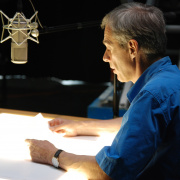
A painter and video maker, Mario Côté lives and works in Montreal. Since 1994 he has taught at the School of Visual and Media Arts at the University of Quebec (UQAM). He is an active member of the Hexagram Centre for Research in Media Arts/UQAM. The initiator of several collaborations in the field of experimental video, he explores the notion of the “dancer body” in the field of experimental video with the multidisciplinary artist Françoise Sullivan and choreographer Jeanne Renaud, that of the “reader body” with several writers, actors, composers and filmmakers. He has directed the ARC_PHONO (2005-2012) and ARC_DANSE (2009-2015) research groups and has explored the notion of interdisciplinary translation in painting by transposing several pieces by the American composer Morton Feldman. A retrospective of his paintings and photographs, «Tableau», was presented at the Musée d’Art de Joliette by the independent curator Nicole Gingras in 2002. Curated by Patrice Loubier, a major show of his work, «Table d’écoute», will be held at the Musée Régional de Rimouski this year.
Ramy Fischler

Ramy Fischler (Belgium, age 37) opened his own design studio after ten years working alongside Patrick Jouin, and after a residency at the Villa Medici in 2010. A graduate of the École Nationale Supérieure de Création Industrielle in Paris, his practice embraces every aspect of design: industrial, artistic and cultural
Arnaud Petit

Composer Arnaud Petit has taken an interest in and worked with the image in its many different forms. Choosing to work with silent films at IRCAM in the late 1980's, he used music and sound to develop the theatrical power of images. In his opera, La Place de la république, premiered at the Centre Pompidou in the early 1990s, he himself made a central cinematic part of the opera. He has also been interested in the sound and music dimension of exhibitions (especially «Les immatériaux» with Jean-François Lyotard). Since then, orchestral and electronic music has played an important part in his work. He is also interested in the link between popular music and written music and in 2013 created the Chaos Orchestra with Daniel Yvinec in order to explore it. He is currently working on an adaptation of a text by Nicolas Bouvier, Halla San, for soprano, actor and percussion ensemble, which will be premiered in January 2016 at the Théâtre de la Ville/Théâtre des Abbesses, by the Percussions Claviers de Lyon. He has won several awards in Europe and the United States (Lavoisier Laureate, Villa Medici, McDowell Fellow, International Theatre Institute, etc.).
João Pedro Rodrigues

Born 1966 in Lisbon, João Pedro Rodrigues is a Portuguese filmmaker and screenwriter. João Pedro Rodrigues recently shot L’ornithologiste, a feature film coproduced by Le Fresnoy - Studio national, which he presents below. Le Fresnoy will also help produce a short film for a retrospective of Rodrigues’s work to he held at the Centre Pompidou in late 2016.
Cyril Teste

Director Cyril Teste founded MxM, a group that specialises in theatrical and digital expression, in 2000. His work has been seen, notably at the Festival d’Avignon, the Festival Européen Temps d’Images-Arte at La Ferme du Buisson and at CENQUATRE-Paris, and at Festival CINEMED in Montpellier. Since 2011, Cyril Teste and MxM have been working on the concept of the film-performance. To date, Teste has produced four such pieces: Patio–2011, Park–2012, Punk Rock in 2015 and Nobody, a site-specific film performance 2013 recreated for the stage–2015 (coproduced with Le Fresnoy).
2014-2015
Arnaud Petit
![]()
Composer Arnaud Petit has been interested in, and has worked with the image, in various forms, for some time. Working with silent film (The Passion of Joan of Arc by K. Dreyer, Tabu by W. Murnau) at the IRCAM in the late 80s, he heightened the original power of the image’s mise-en-scène by the use of music and sound. In the opera La Place de la République, premiered at the Pompidou Centre in the early 90s, he was responsible for creating the central cinematographic part of the opera. The power of music when confronted or combined with images is not neutral. Arnaud Petit endeavoured to make this his primary focus in a spectacular context that shocked or surprised many at the time. Since then, orchestral, as well as electronic music have played an important role in his productions, as have various operas. La bête dans la jungle [The Beast in the Jungle] based on the novella of the same name by Henry James will soon be reprised at the Cologne Opera House.
Cyril Teste
![]()
Born in 1975, Cyril Teste was initially interested in the visual arts before being drawn to theatre.
He studied at the École Régionale d’Acteur in Cannes, then at the CNSAD de Paris, and in 2000, founded Collectif MxM. His work has featured in festivals such as the 58th and 65th editions of the Festival d’Avignon, the Festival Européen Temps d’Images – Arte at LA Ferme du Buisson, the CENTQUATRE Paris, and the Festival International du Cinéma Méditerranéen in Montpellier. Cyril Teste and Collectif MxM (comprising actors, videographers, a composer, a playwright, a cameraman and a lighting engineer, their involvement depending on the show or project) are partner-artists with the CENTQUATRE-Paris, the Canal-Théâtre Intercommunal of Redon, and the Lux-Scène Nationale, Valence.
Since 2011, Cyril Teste and Collectif MxM have been working on the concept of film or cinematic performance (shooting, editing, calibration and mixing in real time under the public’s gaze). Three film performances have been created in this fashion: Patio (2011), Park (2012) and Nobody (2013).
Manon de Boer
Manon de Boer (°1966 in Kodaicanal, India) completed her artistic education at the Akademie Van Beeldende Kunsten, Rotterdam, and at the Rijksakademie van Beeldende Kunsten in Amsterdam. Using personal narration and musical interpretation as both method and subject, de Boer explores the relationship between language, time, and truth claims to produce a series of portrait films in which the film medium itself is continuously interrogated. Her work has been exhibited internationally, at the Venice Biennial (2007), Berlin Biennial (2008), Sao Paolo Biennial (2010), Documenta (2012), Festival international d'art de Toulouse (2014) and has also been included in numerous film festivals in Hong Kong, Marseille, Rotterdam and Vienna. Her work has been the subject of monographic exhibitions at Witte de With in Rotterdam (2008), Frankfurter Kunstverein (2008), London South Gallery (2010), Index in Stockholm (2011), Contemporary Art Museum of St Louis (2011) and Museum of Art Philadelphia (2012), Van Abbe Museum, Eindhoven (2013) among others.
Patrick Bailly Maître Grand
![]()
After studying science (MA in Physical Science, 1969) and devoting ten years to painting, Patrick Bailly-Maître-Grand has been working with photography and photographic techniques since 1980. His work, strictly analogue, black and white gelatin-silver based, is characterized by a playful imagination, combined with a taste for complex technologies such as the Daguerreotype, peripheral photography, strobe photography, chemical toning, direct monotypes, rayographs and other inventions of his own making.
Fleeing the notion of perspective, his images, although very sophisticated in terms of their elaboration, are as simple as visual proverbs, as minimal as haikus.
Patrick Bailly-Maître-Grand has exhibited worldwide and his works feature in the collections of prestigious museums such as MoMA, New York, the Pompidou Centre, Paris, the Fonds National d'Art Contemporain, the Victoria Museum, Melbourne, the Sainsbury Centre for Visual Arts, Norwich (UK), the Musée d'Art Moderne et Contemporain, Strasbourg, and the Museet for Fotokunst, Odense, etc.
Ramy Fischler
![]()
I usually define myself as an industrial designer, but the industry today is not easy to define or to understand, in a world where production machines, like objects, are becoming dematerialized, and where usages and business models are becoming global. A world that seems fuller, and yet is drained, that is constantly challenging us to renew, redefine and rebuild in new ways. It is this world, which some have termed “post-industrial” that inspires my approach and my productions. Whether I’m designing a handcrafted object, an exhibition, an industrial product or a virtual interface, the task in hand always provides me with a new opportunity to immerse myself in a particular area, to observe, to exhaust the subject and its potential, and to establish a collective synergy, the content and the appearance of which, are as important as the final result, even more so. Indeed, the exchange of ideas, research and experimentation, necessary for all innovation, not only allows designers to survive and develop, but also manufacturers and scientists, who increasingly collaborate with the former. The designer often finds himself in a position most favourable to initiating new encounters between the principal actors of worlds that are usually apart. This crisscrossing of knowledge and ideas — which remains, in my practice, the only essential or immutable tool — allows me to discover and understand techniques and issues that are constantly changing. What I share with Le Fresnoy is the will and the ability to connect creative spheres. To seek to know, to interact, and to enter into a dialogue with the worlds around us. Whether virtual or physical — and increasingly both at the same time — our creations and projects are dependent on techniques, and technology, without which we could not implement them, and that are constantly evolving, and indeed, sometimes escape us. However in today’s world, these digital tools, these mutant technologies, are all factors that we need to know, to understand and master, but also question, divert, and use in other contexts, for other purposes.
Vincent Dieutre
![]()
And thus the space opened, much to our incredulity. It still smelled of paint, and visitors got lost in the maze that was this magnificent building site with the badges allowing a somewhat erratic access to the buildings. But one thing was now irreversible: from now on, Le Fresnoy - Studio National des Arts Contemporains would be a force to be reckoned with! It was predicted that this new space would be the “Villa Medici amidst miners’ cottages,” we babbled about a birthplace of new possibilities, a school and a laboratory where film, video, installation, online digital art, dance, architecture and literature would weave together. In short, our ambition was huge, prolific, and we were at the forefront, at once the suspicious and curious guinea pigs of an unprecedented educational and artistic experience. The first students were there, somewhat defensive, carefully half opening the basement windows, allowing them to contemplate from the depths of the familiar sadness of a rather forgotten North, the landscape of a rapidly changing globalized art world. They came from all over, and certain personalities gradually asserted themselves: Laurent Grasso, Anri Sala, Christelle Lheureux, Julien Loustau.
And now some fifteen or so years later, I once again find myself on board the ship that has become a long haul vessel. Disciplinary exploration and the mastery of digital technologies by artists are now second nature. As a school, and as a space of exhibition and production, Le Fresnoy has shown what it is capable of: what once seemed an improbable and vague heterotopia has become a reference of its genre that is copied the world over. Some students have become stars, others exceptional teachers.
2013-2014
Jean-Claude Brisseau
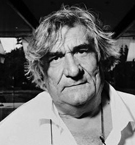 A film-lover from his earliest years, Jean-Claude Brisseau was born on July 17, 1944, in Paris. He has often dealt with taboo subjects. In the La Vie comme ça, his first full-length professional film, he came to grips with life in the suburbs, then, in De bruit et de fureur, the focus turned to delinquency. In his three subsequent movies (Choses secrètes, Les Anges exterminateurs, A l’aventure), he went out on a limb to tackle the greatest taboo of all: sex.
A film-lover from his earliest years, Jean-Claude Brisseau was born on July 17, 1944, in Paris. He has often dealt with taboo subjects. In the La Vie comme ça, his first full-length professional film, he came to grips with life in the suburbs, then, in De bruit et de fureur, the focus turned to delinquency. In his three subsequent movies (Choses secrètes, Les Anges exterminateurs, A l’aventure), he went out on a limb to tackle the greatest taboo of all: sex.
Choses secrètes, one of his most beautiful films, shows two young women employing their abundant charms as weapons to infiltrate the highest levels of society and power, playing a dangerous game that they end up losing. Les Anges exterminateurs (2006), meanwhile, dives deep into the mysteries of desire and female pleasure lived as a form of mysticism. Propelled by magnificent performances from the young actresses and telling of a filmmaker ensnared in a web of his own devising, the movie’s intent is not to provoke, but to explore and experiment in an audacious game of mirrors and mise-en-abyme.
Jean-Claude Brisseau’s most recent feature, La Fille de nulle part, signals an emotional return to his sources. Self-financed, its stars Brisseau himself and is primarily shot in his apartment, rather like the amateur films of his early days—though digital (employed by Brisseau here for the first time) has replaced super-8. The film reminds one of those works by directors who no longer have anything to prove, but who remain keen to experiment, such as Francis Ford Coppola’s recent Twixt. Rather than betraying resignation, the narrowly-focused subject (the platonic relationship between an old teacher and an unruly girl) and the modest means deployed emerge as an authentic demonstration of political and economic resistance, a veritable manifesto of guerrilla cinema. In the hands of a director obsessed by style and form, the lightweight shoot and micro budget do not equate to amateurishness. For Brisseau, everything is a question of direction, and La Fille de nulle part provides a textbook lesson in filmmaking, symptomatic of Brisseau’s fidelity to certain aesthetic precepts of New Wave, but also to the classic American movie (and Hitchcock, especially). If it rehearses the director’s mystical and ethical concerns, with once again incursions from the paranormal and spiritualism, La Fille de nulle part is enriched by a surprising emotional dimension that makes it far more than a theoretical discourse. In the portrait of an ageing man, both misanthrope and idealist, Brisseau, indulging in autobiography for the first time, unpacks a strange, intimate confession, without ever abandoning his fondness for romance.
If his own appearance is touching, Brisseau confirms his reputation as a masterly director of female performers, obtaining a glorious contribution from Virginia Legeay, a onetime student on the screenwriting course at the Fémis, who, in spite of a minor role in Les Anges exterminateurs, never dreamt of becoming an actor.
Olivier Père
Directeur de l’Unité Cinéma / ARTE France
Directeur Général Délégué / ARTE France Cinéma).
Bernard Faucon
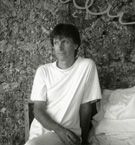 Born in Provence in 1950, after studying philosophy and theology, Bernard Faucon became one of the first artists to explore the potential of the photographic tableau. Begun in 1976, he deliberately interrupted his work in 1995 because he became convinced that the stage of photographic mise en scène hailed the swansong of photography, the last stage before the reign of the pure, digital advertising image. A moment when the belief in the power of photographic truth was still sufficiently prevalent for one to indulge in the luxury of concocting “real-life fictions.”
Born in Provence in 1950, after studying philosophy and theology, Bernard Faucon became one of the first artists to explore the potential of the photographic tableau. Begun in 1976, he deliberately interrupted his work in 1995 because he became convinced that the stage of photographic mise en scène hailed the swansong of photography, the last stage before the reign of the pure, digital advertising image. A moment when the belief in the power of photographic truth was still sufficiently prevalent for one to indulge in the luxury of concocting “real-life fictions.”
For a few years up until 2003 Bernard Faucon developed an event entitled “Le plus beau jour de ma jeunesse” that involved hundreds of young people from 25 countries. A kind of reprieve, which, though it had changed focus, might prolong the ceremony of the tableau: party-going, youth, the innocence of the image.
Bernard Faucon has exhibited all over the world, in particular at Leo Castelli’s in New York, with Agathe Gaillard, Yvon Lambert and Vu la Galerie, in Paris. He is well-known and very popular in both Japan and China.
Robert Henke
 Robert Henke, born in Munich, Germany, builds and operates machines to produce art. Amazed and inspired by the constantly expanding possibilities of applied computer science and technology, Henke explores new territories between musical composition, performance and installation. Alongside diving deeply into aesthetic concepts, the creation of his own instruments and tools is an important and integral part of his artistic process.
Robert Henke, born in Munich, Germany, builds and operates machines to produce art. Amazed and inspired by the constantly expanding possibilities of applied computer science and technology, Henke explores new territories between musical composition, performance and installation. Alongside diving deeply into aesthetic concepts, the creation of his own instruments and tools is an important and integral part of his artistic process.
His focus is the exploration of spaces, structures and timbres and shapes. His material is sound, lights and images, created, shaped and modulated by controlled randomness or mathematical processes, resulting in complex textures, repetitions, audiovisual rhythms and the experience of spectacular virtual and real spaces. The resulting creative output ranges from music played by DJs in clubs, surround sound concerts, musical works in the tradition of academic computer music, video installations, site specific sound art to publicly available software.
Henke is a pioneer of multichannel sound, using methods and systems like wave field synthesis and ambisonics to create situations of total immersion, expanding the sonic experience of his performances beyond of what can be reproduced at home. The interaction between the real space in which the concert happens and the virtual spaces created with his computers is an integral part of that experience. Software architectures of code create sonic architectures that correspond and contrast physical architectures, thus building inspiring tensions and resonances. For Robert Henke, the experience and resulting creation of club music in Berlin in the early 1990s is as much an exploration of social and sonic spaces as musical composition.
His thinking of music more in terms of timbral space and sonic state than in song structures shifted Henke's artistic explorations during the last decade towards the field of installation, both sound based and audio-visual. The computer as a machine for creating endless variations over time is the perfect instrument for these kinds of works.
Starting with his installation ‘Fragile Territories’ in 2012 he is studying the usage of lasers as medium for artistic expression. The contradiction between a potentially highly interesting medium and its common usage as spectacular yet overused and cliché driven visual one trick pony is a challenge that seems worth taking. Currently he is developing a audiovisual concert where the visual component is created with lasers.
Henke’s interest in the combination of art and technology is also evident in his contributions to the development of the music software 'Ableton Live'. Since Ableton’s founding in 1999, he has been central to the development of Live, which became the standard tool for electronic music production and completely redefined the performance practice of electronic music. He writes and lectures about sound and the creative use of computers, and held teaching positions at the Berlin University of the Arts and the Center for Computer Research in Music and Acoustics at Stanford University.
His installations, internet based audiovisual performances and concerts have been presented at Tate Modern London, the Centre Pompidou Paris, Le Lieu Unique Nantes, PS-1 New York, MUDAM Luxembourg, MAK Vienna and on countless festivals.
Bertrand Lamarche
 Born in 1966 in Paris where he lives and works, Bertrand Lamarche is a visual artist. Nominated for the Marcel Duchamp Prize in 2012, his work has been shown in many institutions, including the Palais de Tokyo, the Centre Pompidou, the Pierre Bergé‒Yves Saint Laurent Foundation, the Boghossian Foundation, the CCC, Tours, the FRAC Centre, the FRAC PACA, the Thread Waxing Space, the Anthology Film Archives, the Montreal Biennale... His works feature in many collections, among which: the Fonds National d’Art Contemporain, the Centre Pompidou, the MAC/VAL, the Frac Centre, the Abattoirs, Toulouse, the Musée d’Art Contemporain in Rochechouart, the Plateau FRAC Ile de France, the Musée des Beaux-Arts, Nantes, Agnès b., etc.
Born in 1966 in Paris where he lives and works, Bertrand Lamarche is a visual artist. Nominated for the Marcel Duchamp Prize in 2012, his work has been shown in many institutions, including the Palais de Tokyo, the Centre Pompidou, the Pierre Bergé‒Yves Saint Laurent Foundation, the Boghossian Foundation, the CCC, Tours, the FRAC Centre, the FRAC PACA, the Thread Waxing Space, the Anthology Film Archives, the Montreal Biennale... His works feature in many collections, among which: the Fonds National d’Art Contemporain, the Centre Pompidou, the MAC/VAL, the Frac Centre, the Abattoirs, Toulouse, the Musée d’Art Contemporain in Rochechouart, the Plateau FRAC Ile de France, the Musée des Beaux-Arts, Nantes, Agnès b., etc.
Exploiting spatial and distortions, Bertrand Lamarche proposes a group of sculptural hypotheses that are at once ecstatic and conceptual. His work is rooted in the amplification and the potential for speculation of figures that have featured regularly in his oeuvre for nearly 20 years: the city of Nancy, Kate Bush, meteorology, giant umbellifers, revolving lights, tunnels, record decks.
A large proportion of his oeuvre is characterized by a desire for subjectivation and appropriation, sometimes almost demiurgic, of various areas or figures of reality (The Rotor, The Model). Through modelling, the artist takes over these entities, developing a set of propositions that unsettle viewers because they are generated by looping (Looping, Interview with Kate Bush), or present a mise-en-abyme (Lobby, A Hole in the Screen, La Réplique, Tore), or result from a loss of reference points in space-time (Double Time House, Cosmodisco) and/or distortions in scale (Le terrain Ombelliférique, Vortex).
Not necessarily employing video or mechanical means, his pieces evince a resolutely empirical approach to studio work whence the piece emerges in successive experimental phases through its intrinsic processes of realization. He develops a formally complex and diversified corpus, including as it does installation (le Paratonnerre, Map), photography (Vue du Viaduc John Kennedy, Théorie de la jeune fille), digital video (Le Terrain Ombelliférique), performance (Vortex), sculpture (le Haut du lièvre, la Maison Cosmique), and audio pieces (Try Me).
His works can be viewed as events or stages in a more global fiction/script that sanctions the permeability of the pieces between each other, as well as an organic form of genealogy. In this respect, the work on the Nancy site is significant for the rudimentary cinematographic processes it uses and for the series of successive scenarios it comprises, as in The Fog Factory, Autobrouillard, Cyclocity, or Methendal…
Thomas McIntosh
 Thomas McIntosh, né à Londres en Angleterre en 1972, vit et travaille à Montréal (Canada) Après des études en architecture à l’Université Carleton d’Ottawa et à l’Université Technique de Berlin, il exerce son métier d’architecte pendant quelques années en Allemagne. En 1997, il entame une collaboration avec le compositeur Emmanuel Madan sous le nom de [The User] et produit trois séries majeures de pièces intitulées Symphonie pour imprimantes matricielles (Symphony for dot matrix printers), Silophone et Coincidence Engines. Depuis 1998, leurs pièces et la série Ondulation signée McIntosh ont été abondamment distribuées et présentées un peu partout dans le monde. Thomas McIntosh est lauréat de deux prix du Festival de Nouveau Cinéma et Nouveaux Médias de Montréal ainsi que d’une mention honorable du festival Ars Electronica. McIntosh et Madan ont été en nomination pour le prix Nam June Paik en 2004 et finalistes des prix Quartz à Paris et Transmediale à Berlin en 2010.
Thomas McIntosh, né à Londres en Angleterre en 1972, vit et travaille à Montréal (Canada) Après des études en architecture à l’Université Carleton d’Ottawa et à l’Université Technique de Berlin, il exerce son métier d’architecte pendant quelques années en Allemagne. En 1997, il entame une collaboration avec le compositeur Emmanuel Madan sous le nom de [The User] et produit trois séries majeures de pièces intitulées Symphonie pour imprimantes matricielles (Symphony for dot matrix printers), Silophone et Coincidence Engines. Depuis 1998, leurs pièces et la série Ondulation signée McIntosh ont été abondamment distribuées et présentées un peu partout dans le monde. Thomas McIntosh est lauréat de deux prix du Festival de Nouveau Cinéma et Nouveaux Médias de Montréal ainsi que d’une mention honorable du festival Ars Electronica. McIntosh et Madan ont été en nomination pour le prix Nam June Paik en 2004 et finalistes des prix Quartz à Paris et Transmediale à Berlin en 2010.
Ben Rivers
 Ben Rivers studied Fine Art at Falmouth School of Art, initially in sculpture before moving into photography and super8 film. After his degree he taught himself 16mm filmmaking and hand-processing. His practice as a filmmaker treads a line between documentary and fiction. Often following and filming people who have in some way separated themselves from society, the raw film footage provides Rivers with a starting point for creating oblique narratives imagining alternative existences in marginal worlds.
Ben Rivers studied Fine Art at Falmouth School of Art, initially in sculpture before moving into photography and super8 film. After his degree he taught himself 16mm filmmaking and hand-processing. His practice as a filmmaker treads a line between documentary and fiction. Often following and filming people who have in some way separated themselves from society, the raw film footage provides Rivers with a starting point for creating oblique narratives imagining alternative existences in marginal worlds.
He is the recipient of numerous prizes including: FIPRESCI International Critics Prize, 68th Venice Film Festival for his first feature film Two Years At Sea; the inaugural Robert Gardner Film Award, 2012; the Baloise Art Prize, Art Basel 42, 2011; twice shortlisted for the Jarman Award, 2010/2012; Paul Hamlyn Foundation Award for Artists, 2010. Recent exhibitions include: Slow Action, Hepworth Wakefield, 2012; Sack Barrow, Hayward Gallery, London, 2011; Slow Action, Matt’s Gallery, London and Gallery TPW, Toronto, 2011; A World Rattled of Habit, A Foundation, Liverpool, 2009. Festival retrospectives include Courtisane Festival; Pesaro International Film Festival; London Film Festival; Tirana Film Festival; Punto de Vista, Pamplona; Indielisboa and Milan Film Festival.
In 1996 he co-founded Brighton Cinematheque which he then co-programmed through to its demise in 2006. He continues to programme on a peripatetic basis.
2012-2013
Caroline Champetier
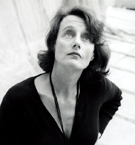 After several years working as assistant to William Lubtchansky, Caroline Champetier debuted as lighting camerawoman on Chantal Akerman's All Night Long in 1981. In 1985 she was lighting camerawoman on Soigne ta droite (1985), the first of seven films she has made with Jean-Luc Godard. She went on to work with Jacques Doillon, Jacques Rivette, Philippe Garrel, Benoît Jacquot, André Téchiné, Barbet Schroeder, and Claude Lanzmann. She has also lent her skills to a new generation of French filmmakers, including Arnaud Desplechin, Christophe Loizillon, Laëtitia Masson, Pascal Rambert, Xavier Beauvois, and Patricia Mazuy. Internationally, she has worked with Nobuhiro Suwa, Amos Gitaï and the Palestinian director Tawfik Abu Wael.
After several years working as assistant to William Lubtchansky, Caroline Champetier debuted as lighting camerawoman on Chantal Akerman's All Night Long in 1981. In 1985 she was lighting camerawoman on Soigne ta droite (1985), the first of seven films she has made with Jean-Luc Godard. She went on to work with Jacques Doillon, Jacques Rivette, Philippe Garrel, Benoît Jacquot, André Téchiné, Barbet Schroeder, and Claude Lanzmann. She has also lent her skills to a new generation of French filmmakers, including Arnaud Desplechin, Christophe Loizillon, Laëtitia Masson, Pascal Rambert, Xavier Beauvois, and Patricia Mazuy. Internationally, she has worked with Nobuhiro Suwa, Amos Gitaï and the Palestinian director Tawfik Abu Wael.
In 2011 she directed the photography for Holy Motors, by Leos Carax, designed the images for an installation by Sophie Calle, Pour la première et la dernière fois, and was behind the camera for Margarethe Von Trotta's film about Hannah Arendt. In July 2012 she began shooting with Claude Lanzmann.
Claire Denis
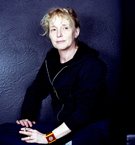 Claire Denis was born in 1948 and spent her childhood in French West Africa. After her film studies, she worked in theatre and as assistant director to Wim Wenders, Jim Jarmusch, Jacques Rivette and others. Denis' first feature Chocolat (1988) is a somewhat autobiographical story of the last colonial days in Cameroon. The subtle and frequently contradictory moods in this film made her lyrical talent immediately obvious.
Claire Denis was born in 1948 and spent her childhood in French West Africa. After her film studies, she worked in theatre and as assistant director to Wim Wenders, Jim Jarmusch, Jacques Rivette and others. Denis' first feature Chocolat (1988) is a somewhat autobiographical story of the last colonial days in Cameroon. The subtle and frequently contradictory moods in this film made her lyrical talent immediately obvious.
She consolidated her reputation as an innovator of French cinema with the brilliant post-film-noir S'en fout la mort (1990), about the illegal cockfighting scene in France and the smaller-scale teenage film U.S. Go Home (1994). In the central party sequence in U.S. Go Home, Denis translates the characters' inner conflicts into rhythm, gestures and sound in a virtuoso choreography. The incestuous undercurrent of this film crops up again in Denis' best-known work, the sibling drama Nénette and Boni (1996). Since their first collaboration for the serial killer film J'ai pas sommeil (1994), it has been clear that Denis has found a kindred spirit in her camerawoman Agnès Godard. This was the film which made Denis' and Godard's names outside of France. It also formed the model for Denis' later works: modern reinterpretations of genre myths and well-known subjects transplanted into an unfamiliar terrain. This is evidenced in a bloody vampire film (Trouble Every Day, 2001), an intense love story (Vendredi Soir, 2002), and two wildly inventive adventure films which represent the highest achievement in her work up until today (Beau Travail, 1999 and L'Intrus, 2004). Claire Denis's films also include 35 Rhums (2008) and White material (2010).
Miguel Gomes
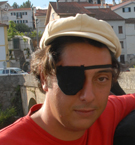 Miguel Gomes studied at the Lisbon Film and Theatre School and worked as a film critic on the Portuguese press between 1996 and 2000. He made several short films which were selected for the festivals of Oberhausen, Belfort and Vila do Conde and screened at the Locarno, Rotterdam, Buenos Aires and Vienna film festivals. La gueule que tu mérites, 2004, was his first feature-length film. In 2008 he showed Ce cher mois d'août, at Cannes (Quinzaine des Réalisateurs), and the film has since been selected for over forty international festivals, garnering some dozen prises. Retrospectives of his films have been shown at the Viennale (Austria, 2008), Bafici (Argentina, 2009) and the Centro de Artes e Imaxes da Corunha (Spain, 2009). Tabu is his third feature film.
Miguel Gomes studied at the Lisbon Film and Theatre School and worked as a film critic on the Portuguese press between 1996 and 2000. He made several short films which were selected for the festivals of Oberhausen, Belfort and Vila do Conde and screened at the Locarno, Rotterdam, Buenos Aires and Vienna film festivals. La gueule que tu mérites, 2004, was his first feature-length film. In 2008 he showed Ce cher mois d'août, at Cannes (Quinzaine des Réalisateurs), and the film has since been selected for over forty international festivals, garnering some dozen prises. Retrospectives of his films have been shown at the Viennale (Austria, 2008), Bafici (Argentina, 2009) and the Centro de Artes e Imaxes da Corunha (Spain, 2009). Tabu is his third feature film.
Nicolas Moulin
 My work concentrates on the practice of urban and suburban landscape and deploys a world in which abandoned modernism cohabits with entropy and failed utopias. Rather than produce documentary work, I seek to question our phantasmagorical relation to reality and to the projections made by our societies regarding their own future. I proceed by distorting the image, changing the references and playing on illusion and appearances. Urban space intrigues me as an expression of ideologies and catalyst of social passions. I derive my photographic "raw material" from my travels and experience on the ground. I first took up this "practice of landscape" in Berlin in the late 1980s, then continued in other countries of the former Eastern Bloc, after 1989. In 1997 I joined the gallery Chez Valentin, which I still work with today. I have on occasion explored "experimental" set-ups combining lowand hi-tech with no obvious hierarchy, notably in Visiover (1997), Metane (1998), and Novomond-Pole (2000). Viderparis (2001) is my first piece of photomontage. In 2002 I spent a year in Iceland, where I made the performance Topokosm. A crossing of a monochrome, monotonous desert, like an absurd raining, following an earlier installation based on the same principle at the Transpalette in Bourges, LDRPE (2002), designated as a training for something indeterminate.
My work concentrates on the practice of urban and suburban landscape and deploys a world in which abandoned modernism cohabits with entropy and failed utopias. Rather than produce documentary work, I seek to question our phantasmagorical relation to reality and to the projections made by our societies regarding their own future. I proceed by distorting the image, changing the references and playing on illusion and appearances. Urban space intrigues me as an expression of ideologies and catalyst of social passions. I derive my photographic "raw material" from my travels and experience on the ground. I first took up this "practice of landscape" in Berlin in the late 1980s, then continued in other countries of the former Eastern Bloc, after 1989. In 1997 I joined the gallery Chez Valentin, which I still work with today. I have on occasion explored "experimental" set-ups combining lowand hi-tech with no obvious hierarchy, notably in Visiover (1997), Metane (1998), and Novomond-Pole (2000). Viderparis (2001) is my first piece of photomontage. In 2002 I spent a year in Iceland, where I made the performance Topokosm. A crossing of a monochrome, monotonous desert, like an absurd raining, following an earlier installation based on the same principle at the Transpalette in Bourges, LDRPE (2002), designated as a training for something indeterminate.
Jean-François Peyret
 Peyret : a theatre of counter -addiction "Technique can, on the contrary, be the resource for a decisive metamorphosis, faced with superannuated aesthetics and the ideological power of culture." Theodor W. Adorno, "Art and the Arts," p. 20
Peyret : a theatre of counter -addiction "Technique can, on the contrary, be the resource for a decisive metamorphosis, faced with superannuated aesthetics and the ideological power of culture." Theodor W. Adorno, "Art and the Arts," p. 20
To finish, because soon it will all finish, Peyret would like to complete Le théâtre et son trouble, a private joke half-way between Artaud and boutade, about the theatre that runs through his mind. An author of essays with his cohorts Jean-Didier Vincent, and, since 2002, Alain Prochiantz, a Brechtian and Sartrian by affinity, Borgesian and Faustian by moments, independent and bad boy with regard to the institution, one with Rimbaud's "I is another" and the "I who that" in Beckett's Unnameable, ultimately Heiner-Mullerian: "Me who/Who is it about when/It is about me/Who is this Me"... Jean-François Peyret, born in the after-gust of Hiroshima, may above all be a kindred spirit of Montaigne (his first theatrical production), who gave him a certain taste for solitude but also one for friendship, leading him to surround himself with a gang. This man who defines himself as a "chaotician" (with shows to prove it and visually and aurally seal the [or] deal) does not fear the idea of the construction site as a metaphor for his work in which "making a scene" is a matter of revolving around a question.
Nicolas Reeves
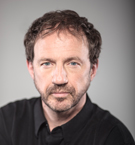 Trained in architecture and physics, a graduate of MIT, Nicolas Reeves is an artist and researcher at the School of Design at Quebec University in Montreal. His work is characterised by the highly poetic use of sciences and technologies. A founder member and, later, academic director of the Hexagram Institute from 2001 to 2009, vice-president of the Société des Arts Technologiques from 1998 to 2008, he directs the NXI GESTATIO laboratory, which explores the formal impact of digital information in all creative fields. He has produced a number of acclaimed works, such as Harpe à Nuages (Cloud Harp) and the [VOILES | SAILS] research programme, which studies the potential of cubic automata capable of developing autonomous behaviour. The winner of several prizes and grants, he has shown work and given talks on four continents.
Trained in architecture and physics, a graduate of MIT, Nicolas Reeves is an artist and researcher at the School of Design at Quebec University in Montreal. His work is characterised by the highly poetic use of sciences and technologies. A founder member and, later, academic director of the Hexagram Institute from 2001 to 2009, vice-president of the Société des Arts Technologiques from 1998 to 2008, he directs the NXI GESTATIO laboratory, which explores the formal impact of digital information in all creative fields. He has produced a number of acclaimed works, such as Harpe à Nuages (Cloud Harp) and the [VOILES | SAILS] research programme, which studies the potential of cubic automata capable of developing autonomous behaviour. The winner of several prizes and grants, he has shown work and given talks on four continents.
2011-2012
- Edwin VAN DER HEIDE
- Ryoichi KUROKAWA
- David ROQUEBY
- Benoit JACQUOT
- Denis COTE
- Jean-Paul FARGIER
2010-2011
- Robert CAHEN
- Christian RIZZO
- Robin RIMBAUD alias Scanner
- Joao-Pedro RODRIGUES
- Mathieu AMALRIC
- Patrick CORILLON
2009-2010
- Robin RIMBAUD alias Scanner
- Jean-François PEYRET
- Ulf LANGHEINRICH
- Hans OP DE BEECK
- Joana HADJITHOMAS et KHALIL JOREIGE
- Luc MOULLET
2008-2009
- Choi CHUNG CHUN
- Andrew KÖTTING
- Arnaud DES PALLIERES
- Christian RIZZO
- Eduardo KAC
- Yann KERSALE
2007-2008
- André S. LABARTHE
- Hannah COLLINS
- Avi MOGRABI
- Andréa MOLINO
- Paul KAISER
- Shelley ESHKAR
- Marc DOWNIE
- Daniel DANIS
2006-2007
- André S.LABARTHE
- Chantal AKERMAN
- Bernard CAVANNA
- Joan FONTCUBERTA
- Ryoji IKEDA
- Daniel DANIS
- Daniel DOBBELS
2005-2006
- Catherine IKAM
- Chantal AKERMAN
- François ROUAN
- Kurt HENTSCHLAGER
- Mauro LANZA
- Paolo PACHINI
- Jean-Marie STRAUB et Danièle HUILLET
2004-2005
- Alain BUFFART et Armando MENICACCI
- Andréa CERA
- André S.LABARTHE
- David LINK
- Gary HILL
- Jean-Luc GODARD
- Hicham BENOHOUD
- Sven PALHSSON
2003-2004
- Andréa CERA
- Atau TANAKA
- Bruno DUMONT
- Charles SANDISON
- Gary HILL
- Gregory CHATONSKY
- Jean-Marie STRAUB et Danièle HUILLET
- S&P STANIKAS
2002-2003
- Fausto ROMITELLI et Paolo PACHINI
- Pier Paolo CALZOLARI
- Jean-Marie STRAUB et Danièle HUILLET
- Antoni MUNTADAS
2001-2002
- Georges APERGHIS
- Tom DRAHOS
- Malachi FARRELL
- Eugène GREEN
- Valérie MREJEN
- Eric POITEVIN
- TSAÏ Ming-Liang
2000-2002
- Alain FLEISCHER
- Edgardo COZARINSKI
- Dominique GONZALEZ-FOERSTER
- Jean-Marie STRAUB et Danièle HUILLET
- Don FORESTA
- Jean-Marc MUSIAL
- Antoni ABAD
1999-2000
- Peter DOWNSBROUGH
- Marcel HANOUN
- Jochen GERZ
- Alain JAUBERT
- Don FORESTA
- Kasper TOEPLITZ
1998-1999
- SARKIS
- Jean-Marie STRAUB et Danièle HUILLET
- Robert KRAMER
- Alain JAUBERT
- Tony BROWN
- Don FORESTA
- Pascal CONVERT
1997-1998
- Anne Teresa DE KEERMAEKER et Thierry DE MEY
- Raoul RUIZ
- SARKIS
- Michael SNOW












